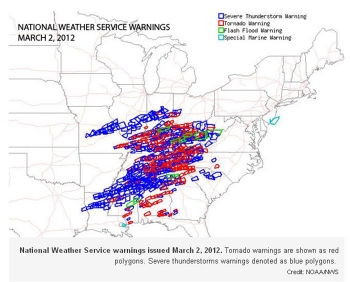NOAA Issues Severe Weather Outlook Three Days Ahead of Tragic Tornado Outbreak
Each year, the United States experiences approximately 1,300 tornadoes. No state is invulnerable to the twisting, destructive winds that emanate from dark thunderstorms–and last week, Nature’s fury was focused on the central and southern states.
Commerce's National Oceanic and Atmospheric Administration (NOAA) has in place a multifaceted tornado early warning system that includes general area outlooks days in advance and that gives individual cities and towns an average of 14 minutes warning before the potentially deadly tornadoes strike. Through a tremendous investment in research, observing systems and forecasting technology, NOAA’s National Weather Service issues more than 1,000 watches and nearly 30,000 warnings for severe storms and tornadoes each year.
On February 29, 2012 that investment resulted in an outlook issued by NOAA’s Storm Prediction Center a full three days ahead of the deadly outbreak. This outlook advised forecasters and the emergency management community that conditions would become favorable for severe thunderstorms and tornadoes.
Advances in research and technology have increased the average warning lead time from only five minutes in the early 1990s to 14 minutes in 2010, thereby giving people and communities more time to seek shelter and reducing loss of life. But technology can only do so much; individuals also need to be prepared for disaster. Visit www.ready.gov to learn more. NOAA Weather Radio webpage The Weather Channel, "Tornado Outbreak: As It Happened"








